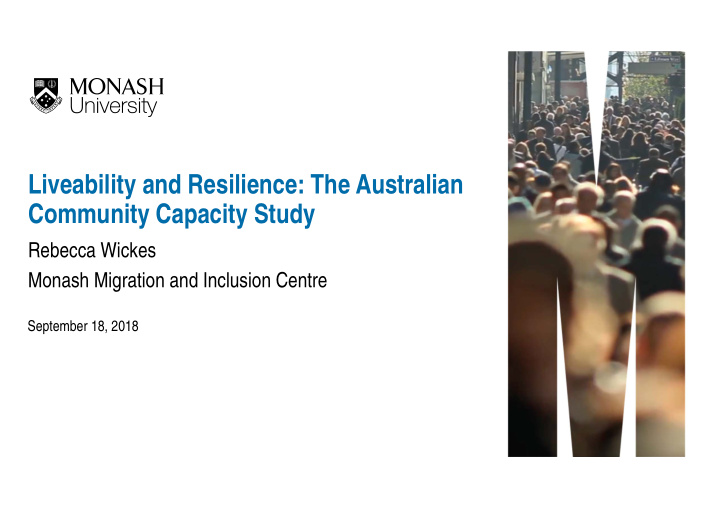



Liveability and Resilience: The Australian Community Capacity Study Rebecca Wickes Monash Migration and Inclusion Centre September 18, 2018
The Research Team Mr Anthony Kimpton Prof Jonathan Corcoran Dr Renee Zahnow
Source: http://aiec.hu/ckfinder/userfiles/images/People‐Culture‐Society‐Arts‐in‐ Australia.jpg Diversity in Australia
10000 20000 30000 40000 50000 60000 0 Jan‐01 Aug‐01 Crime in Brisbane by major offence over time, 100,000 of the Mar‐02 Oct‐02 May‐03 Dec‐03 Jul‐04 OffencesAgainstthePerson Feb‐05 Sep‐05 Apr‐06 Nov‐06 Jun‐07 population Jan‐08 Aug‐08 Mar‐09 Oct‐09 May‐10 OffencesAgainstProperty Dec‐10 Jul‐11 Feb‐12 Sep‐12 Apr‐13 Nov‐13 Jun‐14 Jan‐15 Aug‐15 Mar‐16 Oct‐16 May‐17 Dec‐17 Offence rate 100 200 300 400 500 600 700 800 900 0 Jan‐07 Crime in Perth by major offence over time, 100,000 of the Jun‐07 Nov‐07 Apr‐08 Sep‐08 Feb‐09 Jul‐09 Crimes against the person Dec‐09 May‐10 Oct‐10 population Mar‐11 Aug‐11 Jan‐12 Year Jun‐12 Nov‐12 Apr‐13 Property Offences Sep‐13 Feb‐14 Jul‐14 Dec‐14 May‐15 Oct‐15 Mar‐16 Aug‐16 Jan‐17 Jun‐17 Nov‐17
Crime and Disadvantage City of Wyndham, Victoria City of Ballarat, Victoria
Disadvantage
Disadvantage and Migrant Concentration (SEIFA) in Australian cities Recent Indian Population United Kingdom Arrivals % Population % % Greater Sydney (N=765) ‐0.08* ‐0.07* 0.50*** Greater Melbourne (N=491) ‐0.29*** ‐0.33*** 0.33*** Greater Brisbane (N=445) 0.14** 0.15** 0.33*** Greater Perth (N=333) ‐0.03 ‐0.17** 0.28*** Greater Adelaide (N=415) ‐0.30*** ‐0.32*** 0.15** Greater Hobart (N=90) 0.22 0.13 0.64*** Greater Darwin (N=56) 0.21 0.05 0.41*** ACT (N=98) ‐0.00 0.16 0.05 *= p<0.05, **=p<0.01, ***p<0.001 Residential concentration of Recent, Indian and UK migrants by state suburb classification for major capital cities in Australia (N = the number of state suburbs in each city) 7
Residential Mosaics
The Australian Community Capacity Study • Multi-million dollar project funded exclusively by the Australian Research Council (ARC) and the Victorian Premier and Cabinet led by Wickes and Mazerolle • Studying the life course of urban neighborhoods – one of four studies globally • Includes: 4 waves of survey data in Brisbane 2 waves of survey data in Melbourne 7 in-depth case studies of Brisbane neighborhoods Ethnic community sample of residents from Indian, Vietnamese and Arabic speaking backgrounds in both cities
ACCS/PHDCN and Ecometrics Raudenbush and Sampson (2002) - Taking ecological assessment seriously • Builds on a rich tradition of psychometrics • Treats neighbourhoods as units of analysis in their own right • Develops analytic strategies/approaches that can reliably capture between neighbourhood differences • Ecometric studies mark the “process turn” in neighbourhood effects research (Sampson, 2012)
The Brisbane Research Site 3 rd largest city in Australia Sampling frame 429 suburbs Omitted those without census data (new neighborhoods or highly industrialized areas with few residents. N = 148 suburbs – average of 30 participants per suburb (min = 13 max =68) ACCS Average Pop Long Top‐Up Total Wave of Suburbs Sample Sample Sample Size Size Size Wave 2 5690 1077 3247 4324 Wave 3 6046 2286 1935 4221 Wave 4 6633 2473 1659 4132
Step 1: Capturing distinct land uses within and across suburbs
Social Conduits
Social Holes
Fragmentation index Degree to which the residential area is split into ‘patches’ by highways , thoroughfares , railway lines and rivers .
Step 2: Land use, the socio-demographic context and social sustainability
The Sociodemographic Context Ethnic Disadvantage Diversity Population Residential Density Mobility
Land use, the socio-demographic context and social sustainability Neighbouring Perceptions of Place Collective Social Cohesion Attachment Efficacy Anchoring conduits +ve +ve +ve +ve Local exposure conduits +ve NS NS +ve Scheduled conduits NS NS NS NS Extra local exposure conduits NS NS NS NS Social Holes NS NS NS NS Fragmentation ‐ve ‐ve ‐ve NS Diversity of Land Use Types +ve +ve +ve ‐‐‐ Disadvantage NS ‐ve ‐ve ‐ve Language diversity ‐ve ‐ve ‐ve NS NS = Not Significant/ –ve = Negative / +ve = Positive
In Summary… • Crime and disadvantage concentrate in particular places • Cannot “add conduits and stir” – the composition of the neighbourhood and the coalescence of land use types important for social life • Disadvantage is pernicious • Segregates opportunities for particular groups in society • Erodes social sustainability • Increases violence • Key challenge for LGAs - must simultaneously design out crime and build in opportunities for quality social interactions in disadvantaged areas
Questions/Comments?
Recommend
More recommend